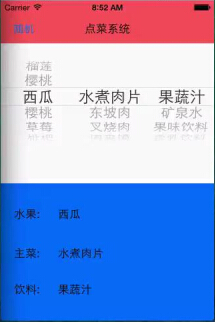iOS基础-UIKit框架-高级视图-UIPickerView-实例1:点菜(列与列之间无关系)

一、点菜
0.准备一个plist文件,Root为Array,其中包含3个数组,每个数组有一堆食物名称
加载这个plist文件
@property(nonatomic,strong)NSArray *foods; -(NSArray *)foods { if(_foods == nil){ NSString *fullPath = [[NSBundle mainBundle] pathForResource:@"foods.plist" ofType:nil]; _foods = [NSArray arrayWithContentsOfFile:fullPath]; } return _foods; }
1.拖一个Picker View控件,设置数据源,遵从数据源协议并实现数据源方法
#pragma mark - 数据源方法 //返回pickerView一共有多少列 -(NSInteger)numberOfComponentsInPickerView:(UIPickerView *)pickerView { return self.foods.count; } //返回pickerView第component列有多少行 -(NSInteger)pickerView:(UIPickerView *)pickerView numberOfRowsInComponents:(NSInteger)component { return self.foods[components].count; }
2.设置代理,遵从代理协议并实现代理方法
#pragma mark - 代理方法 //返回第component列的第row行显示什么内容 -(NSString *)pickerView:(UIPickerView *)pickerView titleForRow:(NSInteger)row forComponents:(NSInteger)component { return self.foods[components][row]; }
二、显示点菜结果
1.拖一个UIView,并在这个UIView上拖6个标签,并将随滚动变化的标签连线
2.实现代理方法(监听选中行)
#pragma mark - 代理方法 //当选中了pickerView的某一行的时候调用 //会将选中的列号和行号作为参数传入 //只有通过手指选中某一行的时候才会调用 -(void)pickerView:(UIPickerView *)pickerView didSelectRow:(NSInteger)row inComponent:(NSInteger)component { //1.获取对应列对应行的数据 NSString *name = self.foods[component][row]; //2.判断选择的是哪一列,根据列号设置对应的数据 if(0 == component){ //水果 self.fruitLabel.text = name; } else if (1 == component) { //主菜 self.stapleLabel.text = name; } else{ //饮料 self.drinkLabel.text = name; } }
3.在ViewDidLoad中设置显示的默认值(模拟手动选中)
for (int component = 0; component<self.foods.count;component++){ [self pcikerView:nil didSelectRow:0 inComponent:component]; }
三、随机选菜
1.拖一个UIView(高度为64,包括状态栏的20),在上面拖1个按钮和1个标签
//居中小技巧:Y为64,(和高度一样),高度为44.
2.监听按钮点击(连线并实现方法)
//这里要拿到pickerView,调用它的方法,所以先将pickerView连线(Outlet)。 #pragma mark - 监听按钮点击 -(IBAction)randomFood:(UIButton *)sender { //让pickerView主动选中某一行 //让pickerView选中inComponent列的Row行 //根据每一列的元素个数生成随机值 for (int component = 0;component <self.foods.count;component++) { //获取对应列的数据总数 int total = [self.foods[component] count]; // 根据每一列的总数生成随机数(当前生成的随机数) int randomNumber = arc4random() % total; //获取当前选中的行(上一次随机后移动到的行) int oldRow = [self.pickerView selectedRowInComponent:0]; //比较上次的行号和当前生成的随机数是否相同,如果相同,重新生成 while(oldRow == randomNumber){ randomNumber = arc4random() % total; } //让pickerVier滚动到某一行 [self.pickerView selectRow:randomNumber inComponent:component animated:YES]; //通过代码选中某一行 [self pcikerView:nil didSelectRow:randomNumber inComponent:component]; } //% 12则永远是[0,11],其他同理,也就是说,有几个数就%几
问:为什么不用self.foods[0].count而用[self.foods[2] count] ?
答:因为self.foods[0] == [self.foods objectAtIndex:0];
而objectAtIndex:方法的返回值是id,id是动态类型,只有运行的时候才知道是什么类型,动态类型没有count方法,所以不能这样调用。而是采取老土的方法[self.foods[2] count]



